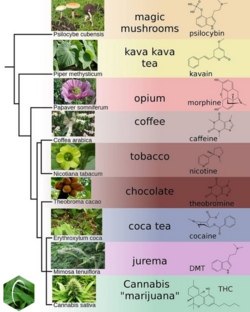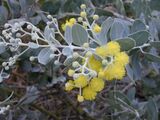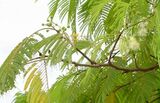Biology:List of psychoactive plants
This is a list of plant species that, when consumed by humans, are known or suspected to produce psychoactive effects: changes in nervous system function that alter perception, mood, consciousness, cognition or behavior. Many of these plants are used intentionally as psychoactive drugs, for medicinal, religious, and/or recreational purposes. Some have been used ritually as entheogens for millennia.[1][2]
The plants are listed according to the specific psychoactive chemical substances they contain; many contain multiple known psychoactive compounds.
Cannabinoids
Species of the genus Cannabis, known colloquially as marijuana, including Cannabis sativa and Cannabis indica, is a popular psychoactive plant that is often used medically and recreationally. The principal psychoactive substance in Cannabis, tetrahydrocannabinol (THC), contains no nitrogen, unlike many (but not all) other psychoactive substances[lower-alpha 1] and is not an indole, tryptamine, phenethylamine, anticholinergic (deliriant) or dissociative drug. THC is just one of more than 100 identified cannabinoid compounds in Cannabis, which also include cannabinol (CBN) and cannabidiol (CBD).
Cannabis plants vary widely, with different strains producing dynamic balances of cannabinoids (THC, CBD, etc.) and yielding markedly different effects. Popular strains are often hybrids of C. sativa and C. indica.
The medicinal effects of cannabis are widely studied, and are active topics of research both at universities and private research firms. Many jurisdictions have laws regulating or prohibiting the cultivation, sale and/or use of medical and recreational cannabis.[citation needed]
Tryptamines
Many of the psychedelic plants contain dimethyltryptamine (DMT), or other tryptamines, which are either snorted (Virola, Yopo snuffs), vaporized, or drunk with MAOIs (Ayahuasca). It cannot simply be eaten as it is not orally active without an MAOI and it needs to be extremely concentrated to be vaporized.
Acanthaceae
Species, Alkaloid content, where given, refers to dried material
- Fittonia albivenis[citation needed], a common ornamental plant from South America.
Aceraceae
- Acer saccharinum (silver maple) was found to contain the indole alkaloid gramine (not active and extremely toxic) 0.05% in the leaves, so it is possible that other members of this plant family contain active compounds.[3]
Aizoaceae
- Delosperma acuminatum, DMT, 5-MeO-DMT[4][unreliable source?]
- Delosperma cooperi, DMT, 5-MeO-DMT[4]
- Delosperma ecklonis, DMT[4]
- Delosperma esterhuyseniae, DMT[4]
- Delosperma hallii, 5-MeO-DMT[4]
- Delosperma harazianum, DMT, 5-MeO-DMT[4]
- Delosperma harazianum
Shibam, DMT[4]
- Delosperma harazianum
- Delosperma hirtum, DMT[4]
- Delosperma hallii
aff. litorale
- Delosperma hallii
- Delosperma lydenbergense, DMT, 5-MeO-DMT[4]
- Delosperma nubigenum, 5-MeO-DMT[4]
- Delosperma pageanum, DMT, 5-MeO-DMT[4]
- Delosperma pergamentaceum, Traces of DMT[4]
- Delosperma tradescantioides, DMT[4]
Apocynaceae
- Prestonia amazonica: DMT[5]
- Voacanga africana: Up to 10% Iboga alkaloids[6]
Asteraceae
Erythroxylaceae
- Erythroxylum pungens: DMT[7]
Fabaceae (Leguminosae)
- Acacia acuminata, Up to 1.5% alkaloids, mainly consisting of dimethyltryptamine in bark & leafCite error: Closing
</ref>missing for<ref>tag[unreliable source?] - Acaciella angustissima, β-methyl-phenethylamine,[8] NMT and DMT in leaf (1.1-10.2 ppm)[9]
- Vachellia aroma, Tryptamine alkaloids.[10] Significant amount of tryptamine in the seeds.[11]
- Acacia auriculiformis, 5-MeO-DMT in stem bark[12]
- Acacia baileyana, 0.02% tryptamine and β-carbolines, in the leaf, Tetrahydroharman[13]
- Acacia beauverdiana, Psychoactive[14] Ash used in Pituri.[15]
- Senegalia berlandieri, DMT, phenetylamine, mescaline, nicotine[16]
- Senegalia catechu, DMT and other tryptamines in leaf, bark[citation needed]
- Vachellia caven, Psychoactive[6]
- Senegalia chundra, DMT and other tryptamines in leaf, bark[citation needed]
- Acacia colei, DMT[17]
- Acacia complanata, 0.3% alkaloids in leaf and stem, almost all N-methyl-tetrahydroharman, with traces of tetrahydroharman, some of tryptamine[18][19][20]
- Acacia confusa, DMT & NMT in leaf, stem & bark 0.04% NMT and 0.02% DMT in stem.[21] Also N,N-dimethyltryptamine N-oxide[22]
- Vachellia cornigera, Psychoactive,[6] Tryptamines[23] DMT according to C. Rastch.
- Acacia cultriformis, Tryptamine, in the leaf, stem[21] and seeds.[11] Phenethylamine in leaf and seeds[11]
- Acacia cuthbertsonii, Psychoactive[6]
- Acacia decurrens, Psychoactive,[6] but less than 0.02% alkaloids[13]
- Acacia delibrata, Psychoactive[14]
- Acacia falcata, Psychoactive,[14] but less than 0.02% alkaloids[13]
- Vachellia farnesiana, Traces of 5-MeO-DMT[24] in fruit. β-methyl-phenethylamine, flower.[25] Ether extracts about 2–6% of the dried leaf mass.[26] Alkaloids are present in the bark[27] and leaves.[28]
- Acacia flavescens, Strongly Psychoactive, Bark[citation needed]
- Acacia floribunda, Tryptamine, phenethylamine,[29] in flowers[11] other tryptamines,[30] DMT,tryptamine,NMT 0.3–0.4% phyllodes.[31]
- Acacia georginae, Psychoactive,[6] plus deadly toxins
- Vachellia horrida, Psychoactive[6]
- Acacia implexa, Psychoactive[32]
- Mimosa jurema, DMT,[6] NMT[citation needed]
- Vachellia karroo, Psychoactive[citation needed]
- Senegalia laeta, DMT, in the leaf[21]
- Acacia longifolia, 0.2% tryptamine in bark, leaves, some in flowers, phenylethylamine in flowers,[29] 0.2% DMT in plant.[33] Histamine alkaloids.[13]
- Acacia sophorae, Tryptamine in leaves, bark[11]
- Acacia macradenia, Tryptamine[11]
- Acacia maidenii, 0.6% NMT and DMT in about a 2:3 ratio in the stem bark, both present in leaves[21]
- Acacia mangium, Psychoactive[6]
- Acacia melanoxylon, DMT, in the bark and leaf,[34] but less than 0.02% total alkaloids[13]
- Senegalia mellifera, DMT, in the leaf[21]
- Vachellia nilotica, DMT, in the leaf[21]
- Vachellian ilotica subsp. adstringens, Psychoactive, DMT in the leaf[citation needed]
- Acacia neurophylla DMT in bark, Harman in leaf.[35]
- Acacia obtusifolia, Tryptamine, DMT, NMT, other tryptamines,[36] 0.4–0.5% in dried bark,0.15–0.2% in leaf, 0.07% in branch tips.[37]
- Vachellia oerfota, Less than 0.1% DMT in leaf,[38] NMT
- Acacia penninervis, Psychoactive[14]
- Acacia phlebophylla, 0.3% DMT in leaf, NMT[21]
- Acacia podalyriifolia, Tryptamine in the leaf,[21] 0.5% to 2% DMT in fresh bark, phenethylamine, trace amounts.[29] Although this species is claimed to contain 0.5% to 2% DMT in fresh bark the reference for this is invalid as there is no reference to Acacia Podalyriffolia anywhere in the reference article. Additionally, well known and proven extraction techniques for DMT have failed to produce any DMT or alkaloids from fresh bark or the leaves on multiple sample taken at various seasons. Should DMT actually exist in this species of Acacia then it exists in extremely small amounts and have failed to produce any alkaloids with Acid/Base extraction techniques using HCl/Na(OH)2. On the same note, more academic research is definitely required into the DMT content of this and other Australian Acacia species with proper chemical analysis of sample.[citation needed]
- Senegalia polyacantha, DMT in leaf[21] and other tryptamines in leaf, bark
- Senegalia polyacantha ssp. campylacantha, Less than 0.2% DMT in leaf, NMT; DMT and other tryptamines in leaf, bark[39]
- Senegalia rigidula: Phenethylamine, tryptamine, tyramine, and β-Methylphenethylamine.[40]
- Acacia sassa, Psychoactive[6]
- Vachellia schaffneri, β-methyl-phenethylamine, Phenethylamine[41]
- Senegalia senegal, Less than 0.1% DMT in leaf,[21] NMT, other tryptamines. DMT in plant,[25] DMT in bark.[11]
- Vachellia seyal, DMT, in the leaf.[21] Ether extracts about 1–7% of the dried leaf mass.[26]
- Vachellia sieberiana, DMT, in the leaf[21]
- Acacia simplex, DMT and NMT, in the leaf, stem and trunk bark, 0.81% DMT in bark, MMT[21][42]
- Vachellia tortilis, DMT, NMT, and other tryptamines[32]
- Acacia vestita, Tryptamine, in the leaf and stem,[21] but less than 0.02% total alkaloids[13]
- Acacia victoriae, tryptamines, 5-MeO-alkyltryptamine[11]
- List of acacia species having little or no alkaloids in the material sampled:[13]
(0% [math]\displaystyle{ \le }[/math] C [math]\displaystyle{ \le }[/math] 0.02%, Concentration of alkaloids) - Pseudalbizzia inundata leaves contain DMT.[6]
- Anadenanthera colubrina, Bufotenin, Beans,[43][44] Bufotenin oxide, Beans,[43] N,N-Dimethyltryptamine, Beans,[43][44] pods,[43]
- Anadenanthera colubrina var. cebil – Bufotenin and Dimethyltryptamine have been isolated from the seeds and seed pods, 5-MeO-DMT from the bark of the stems.[45] The seeds were found to contain 12.4% bufotenine, 0.06% 5-MeO-DMT and 0.06% DMT.[46]
- Anadenanthera peregrina,
1,2,3,4-Tetrahydro-6-methoxy-2,9-dimethyl-beta-carboline, Plant,[47] 1,2,3,4-Tetrahydro-6-methoxy-2-methyl-beta-carboline, Plant,[44] 5-Methoxy-N,N-dimethyltryptamine, Bark,[44] 5-Methoxy-N-methyltryptamine, Bark,[44] Bufotenin, plant,[44] beans,[43] Bufotenin N-oxide, Fruit,[44] beans,[43] N,N-Dimethyltryptamine-oxide, Fruit[44][48]
- Anadenanthera peregrina var. peregrina, Bufotenine is in the seeds.[49]
- Desmanthus illinoensis, 0–0.34% DMT in root bark, highly variable.[50] Also NMT, N-hydroxy-N-methyltryptamine, 2-hydroxy-N-methyltryptamine, and gramine (toxic).[51]
- Desmanthus leptolobus, 0.14% DMT in root bark, more reliable than D. illinoensis[50]
- Desmodium caudatum[52] (syn. Ohwia caudata), Roots: 0.087% DMT,
- Codariocalyx motorius(syn. Desmodium gyrans), DMT, 5-MeO-DMT, leaves, roots[citation needed]
- Desmodium racemosum, 5-MeO-DMT[6]
- Desmodium triflorum, 0.0004% DMT-N-oxide, roots,[53] less in stems[53] and trace in leaves.[53]
- Lespedeza capitata[6]
- Lespedeza bicolor, DMT, 5-MeO-DMT in leaves and roots[54]
- Lespedeza bicolor var. japonica, DMT, 5-MeO-DMT[6] in leaves and root bark
- Mimosa ophthalmocentra, Dried root: DMT 1.6%, NMT 0.0012% and hordenine 0.0065%[55]
- Mimosa scabrella, tryptamine, NMT, DMT and N-methyltetrahydrocarboline in bark[56]
- Mimosa somnians, tryptamines and MMT[citation needed]
- Mimosa tenuiflora (syn. "Mimosa hostilis"), 0.31-0.57% DMT (dry root bark).[57]
- Mimosa verrucosa, DMT[58] in root bark
- Mucuna pruriens, the seeds of the plant contain about 3.1–6.1% L-DOPA.[59]
- Petalostylis casseoides, 0.4–0.5% tryptamine, DMT, etc. in leaves and stems[54]
- Petalostylis labicheoides var. casseoides, DMT[6] in leaves and stems; 0.4–0.5% alkaloids in leaves and stems;[60] Tryptamines in leaves and stems, MAO's up to 0.5%[61][unreliable source?]
- Phyllodium pulchellum(syn. Desmodium pulchellum), DMT;[6] 0.2% 5-MeO-DMT, small quantities of DMT[54] DMT (dominates in seedlings and young plants), 5-MeO-DMT (dominates in mature plant), whole plant, roots, stems, leaves, flowers;
- Erythrina flabelliformis, other Erythrina species, seeds contain the alkaloids erysodin and erysovinCite error: Closing
</ref>missing for<ref>tag[unreliable source?]===
Malpighiaceae
- Diplopterys cabrerana: McKenna et al. (1984) assayed and found the leaves contain 0.17% DMT[62]
Myristicaceae
- Horsfieldia superba: 5-MeO-DMT[54] and beta-carbolines[60]
- Iryanthera macrophylla: 5-MeO-DMT in bark;[54]
- Iryanthera ulei: 5-MeO-DMT in bark[6]
- Osteophloem platyspermum: DMT, 5-MeO-DMT in bark
- Virola calophylla, Leaves 0.149% DMT, leaves 0.006% MMT 5-MeO-DMT in bark[63]
- Virola calophylloidea, DMT, 5-MeO-DMT[6]
- Virola carinata, DMT in leaves; DMT, 5-MeO-DMT[6]
- Virola cuspidata, DMT[61]
- Virola divergens, DMT[6] in leaves
- Virola elongata(syn. Virola theiodora), DMT, 5-MeO-DMT[6] in bark, roots, leaves and flowers
- Virola melinonii, DMT in bark; DMT, 5-MeO-DMT[6]
- Virola multinervia, DMT, 5-MeO-DMT[6] in bark and roots
- Virola pavonis, DMT[6] in leaves
- Virola peruviana, DMT, 5-MeO-DMT;[6] 5-MeO-DMT, traces of DMT and 5-MeO-tryptamine in bark
- Virola rufula, Alkaloids in bark and root, 95% of which is MeO-DMT[64] 0.190% 5-MeO-DMT in bark, 0.135% 5-MeO-DMT in root, 0.092% DMT in leaves.
- Virola sebifera, The bark contains 0.065% to 0.25% alkaloids, most of which are DMT and 5-MeO-DMT.[65]
- Virola venosa, DMT, 5-MeO-DMT[6] in roots, leaves DMT
Ochnaceae
- Testulea gabonensis: 0.2% 5-MeO-DMT, small quantities of DMT,[54] DMT in bark and root bark, NMT[citation needed]
Pandanaceae
Poaceae (Gramineae)
Some Graminae (grass) species contain gramine, which can cause brain damage, other organ damage, central nervous system damage and death in sheep.[66]
- Arundo donax, 0.0057% DMT in dried rhizome, no stem, 0.026% bufotenine, 0.0023% 5-MeO-MMT[67]
- Phalaris aquatica, 0.0007–0.18% Total alkaloids,[68] 0.100% DMT,[69] 0.022% 5-MeO-DMT,[69] 0.005% 5-OH-DMT[69]
- Phalaris arundinacea, 0.0004–0.121% Total alkaloids[68]
- Phalaris brachystachys, aerial parts up to 3% total alkaloids, DMT present[citation needed]
- Phragmites australis, DMT, 5-MeO-DMT, bufotenine and gramine in the rhizome.[70]
None of the above alkaloids are said to have been found in Phalaris californica, Phalaris canariensis, Phalaris minor and hybrids of P. arundinacea together with P. aquatica.[68]
Polygonaceae
Rubiaceae
- Psychotria carthagenensis, 0.2% average DMT in dried leaves.[71]
- Psychotria colorata, Presence of mu opioid receptor(MOR) agonist and NMDA antagonist: hodgkinsine, psychotridine. Also mentioned in The Encyclopedia of Psychoactive Plants: Ethnopharmacology and Its Applications.[72]
- Psychotria expansa, DMT[61]
- Psychotria forsteriana, DMT[61]
- Psychotria insularum, DMT[61]
- Psychotria poeppigiana,[73] DMT[61]
- Psychotria rostrata, DMT[61]
- Psychotria rufipilis, DMT[61]
- Psychotria viridis, DMT 0.1–0.61% dried mass.[74]
Rutaceae[75][76]
- Dictyoloma incanescens, 5-MeO-DMT in leaves,[64] 0.04% 5-MeO-DMT in bark[54]
- Dutaillyea drupacea, > 0.4% 5-MeO-DMT in leaves[32]
- Dutaillyea oreophila, 5-MeO-DMT[6] in leaves
- Tetradium ruticarpum(syn. Evodia rutaecarpa), 5-MeO-DMT[6] in leaves, fruit and roots
- Limonia acidissima, Traces of DMT;[6] 5-MeO-DMT in stems[citation needed]
- Euodia leptococca (formerly Melicope), 0.2% total alkaloids, 0.07% 5-MeO-DMT; 5-MeO-DMT in leaves and stems, also "5-MeO-DMT-Oxide and a beta-carboline"[60]
- Pilocarpus organensis, DMT, 5-MeO-DMT in leaves[77] (Might also contain pilocarpine)
- Vepris ampody, Up to 0.2% DMT in leaves and branches[54]
- Zanthoxylum arborescens, Traces of DMT;[6] DMT in leaves
- Zanthoxylum procerum, DMT in leaves[citation needed]
- Citrus limon, DMT, N-Methylated tryptamine derivative in leaves[78][79]
- Citrus sinesis,DMT, N-Methylated tryptamine derivative[78][79]
- Citrus bergamia,DMT, N-Methylated tryptamine derivative[78][79]
- Mandarin orange Traces of N-methylated tryptamine derivative in leaf.[80][79]
- Chinotto Tree, N-Methylated tryptamine derivative in leaf[80][79]
- Citrus medica, N-Methylated tryptamine derivative in leaf[80][79]
Phenethylamines
Species, Alkaloid Content (Fresh) – Alkaloid Content (Dried)
- Coryphantha contains various phenethylamine alkaloids including macromerine, coryphanthine, O-methyl-candicine, corypalmine, and N-methyl-corypalmine.[81][82]
- Cylindropuntia echinocarpa (syn. Opuntia echinocarpa), Mescaline 0.01%, DMPEA 0.01%, 4-hydroxy-3-5-dimethoxyphenethylamine 0.01%[83]
- Cylindropuntia spinosior (syn. Opuntia spinosior),[84] Mescaline 0.00004%, 3-methoxytyramine 0.001%, tyramine 0.002%, 3-4-dimethoxyphenethylamine.[83]
- Echinopsis lageniformis (syns Echinopsis scopulicola, Trichocereus bridgesii), Mescaline > 0.025%,[85] also DMPEA < 1%, 3-methoxytyramine < 1%, tyramine < 1%; Mescaline 2%[86]
- Echinopsis macrogona (syn. Trichocereus macrogonus), > 0.01–0.05% Mescaline[87]
- Echinopsis pachanoi (syn. Trichocereus pachanoi), Mescaline 0.006–0.12%, 0.05% Average;[88] Mescaline 0.01%–2.375%[88]
- Echinopsis peruviana (syn. Trichocereus peruvianus), Mescaline 0.0005%–0.12%;[88] Mescaline
- Echinopsis spachiana (syn. Trichocereus spachianus), Mescaline;[83] Mescaline[83]
- Echinopsis tacaquirensis subsp. taquimbalensis (syn. Trichocereus taquimbalensis),[89][unreliable source?] > 0.005–0.025% mescaline[87]
- Echinopsis terscheckii (syn. Trichocereus terscheckii, Trichocereus werdemannianus)[90][unreliable source?] > 0.005–0.025% Mescaline;[87] mescaline 0.01%–2.375%[88]
- Echinopsis valida, 0.025% mescaline[91][better source needed]
- Lophophora williamsii (Peyote), 0.4% Mescaline;[91][better source needed] 3–6% Mescaline[83]
- Opuntia acanthocarpa Mescaline[92]
- Opuntia basilaris Mescaline 0.01%, plus 4-hydroxy-3-5-dimethoxyphenethylamine[83][better source needed]
- Pelecyphora aselliformis, mescaline[91][better source needed]
Beta-carbolines


Beta-carbolines are "reversible" MAO-A inhibitors. They are found in some plants used to make Ayahuasca. In high doses the harmala alkaloids are somewhat hallucinogenic on their own. β-carboline is a benzodiazepine receptor inverse agonist and can therefore have convulsive, anxiogenic and memory enhancing effects.[93]
Apocynaceae
- Amsonia tabernaemontana, Harman[6]
- Aspidosperma exalatum, Beta-carbolines[94]
- Aspidosperma polyneuron, Beta-carbolines[94]
- Apocynum cannabinum, Harmalol[6]
- Ochrosia nakaiana, Harman[6]
- Pleiocarpa mutica, Beta-carbolines[94]
Bignoniaceae
- Newbouldia laevis, Harman[citation needed]
Calycanthaceae
- Calycanthus occidentalis, Harman;[6] Harmine
Chenopodiaceae
Combretaceae
- Guiera senegalensis, Tetrahydroharmine;[6] Harman, etc.
Cyperaceae
- Carex brevicollis, Harmine, etc.[6]
- Carex parva, Beta-carbolines[94]
Elaeagnaceae
- Elaeagnus angustifolia, Harman, etc.[6]
- Elaeagnus commutata, Beta-carbolines[94]
- Elaeagnus hortensis, Tetrahydroharman, etc.[6]
- Elaeagnus orientalis, Tetrahydroharman[6]
- Elaeagnus spinosa, Tetrahydroharman[6]
- Hippophae rhamnoides, Harman, etc.[6]
- Shepherdia argentea, Tetrahydroharmol[6]
- Shepherdia canadensis, Tetrahydroharmol[6]
Gramineae
- Arundo donax, Tetrahydroharman, etc.[6]
- Festuca arundinacea, Harman, etc.[6]
- Lolium perenne, (Perennial Ryegrass), Harman, etc.[6]
- Phalaris aquatica, Beta-carbolines[94]
- Phalaris arundinacea, Beta-carbolines[94]
Lauraceae
- Nectandra megapotamica, Beta-carbolines[94]
Leguminosae
- Acacia baileyana, Tetrahydroharman[6]
- Acacia complanata, Tetrahydroharman,[6] etc.
- Burkea africana, Harman, etc.[6]
- Desmodium gangeticum, Beta-carbolines[94]
- Desmodium gyrans, Beta-carbolines[94]
- Desmodium pulchellum, Harman, etc.[citation needed]
- Mucuna pruriens, 6-Methoxyharman, Dihydroharman, Harman[6]
- Petalostylis labicheoides, Tetrahydroharman; MAO's up to 0.5%[61]
- Prosopis nigra, Harmalicin, Harman, etc.[6]
- Shepherdia pulchellum, Beta-carbolines[94]
Loganiaceae
- Strychnos melinoniana, Beta-carbolines[94]
- Strychnos usambarensis, Harman[94]
Malpighiaceae
- Banisteriopsis argentia, 5-methoxytetrahydroharman, (−)-N(6)-methoxytetrahydroharman, dimethyltryptamine-N(6)-oxide[8]
- Banisteriopsis caapi, Harmine 0.31–0.84%,[95] tetrahydroharmine, telepathine, dihydroshihunine,[96] 5-MeO-DMT in bark[97]
- Banisteriopsis inebrians, Beta-carbolines[94]
- Banisteriopsis lutea, Harmine, telepathine[8]
- Banisteriopsis metallicolor, Harmine, telepathine[8]
- Banisteriopsis muricata Harmine up to 6%, harmaline up to 4%, plus DMTCite error: Closing
</ref>missing for<ref>tag[failed verification]
Myristicaceae
- Gymnacranthera paniculata, Beta-carbolines[94]
- Horsfieldia superba Beta-carbolines[60]
- Virola cuspidata, 6-Methoxy-Harman[6]
- Virola rufula, Beta-carbolines[94]
- Virola theiodora, Beta-carbolines[94]
Ochnaceae
- Testulea gabonensis, Beta-carbolines[94]
Palmae
- Plectocomiopsis geminiflora, Beta-carbolines[94]
Papaveraceae
- Meconopsis horridula, Beta-carbolines[94]
- Meconopsis napaulensis, Beta-carbolines[94]
- Meconopsis paniculata, Beta-carbolines[94]
- Meconopsis robusta, Beta-carbolines[94]
- Meconopsis rudis, Beta-carbolines[94]
- Papaver rhoeas, Beta-carbolines[94]
Passifloraceae
- Passiflora actinia, Harman[6]
- Passiflora alata, Harman[6]
- Passiflora alba, Harman[6]
- Passiflora bryonoides, Harman[6]
- Passiflora caerulea, Harman[6]
- Passiflora capsularis, Harman[6]
- Passiflora decaisneana, Harman[6]
- Passiflora edulis, Harman,[6] 0–7001 ppm[25] in fruit
- Passiflora eichleriana, Harman[6]
- Passiflora foetida, Harman[6]
- Passiflora incarnata (with bee), Harmine, Harmaline, Harman, etc. 0.03%.[98] Alkaloids in rind of fruit 0.25%[98]
- Passiflora quadrangularis, Harman[6]
- Passiflora ruberosa, Harman[6]
- Passiflora subpeltata, Harman[6]
- Passiflora warmingii, Harman[6]
Polygonaceae
- Calligonum minimum, Beta-carbolines[94]
- Leptactinia densiflora, Tetrahydroharmine,[6] etc.
- Ophiorrhiza japonica, Harman[6]
- Pauridiantha callicarpoides, Harman[6]
- Pauridiantha dewevrei, Harman[6]
- Pauridiantha lyalli, Harman[6]
- Pauridiantha viridiflora, Harman[6]
- Simira klugei, Harman[6]
- Simira rubra, Harman[6]
Rubiaceae
- Borreria verticillata, Beta-carbolines[94]
- Leptactinia densiflora, Beta-carbolines[94]
- Nauclea diderrichii, Beta-carbolines[94]
- Ophiorrhiza japonica, Beta-carbolines[94]
- Pauridiantha callicarpoides, Beta-carbolines[94]
- Pauridiantha dewevrei, Beta-carbolines[94]
- Pauridiantha yalli, Beta-carbolines[94]
- Pauridiantha viridiflora, Beta-carbolines[94]
- Pavetta lanceolata, Beta-carbolines[94]
- Psychotria carthagenensis, Beta-carbolines[94]
- Psychotria viridis, Beta-carbolines[94]
- Simira klugei, Beta-carbolines[94]
- Simira rubra, Beta-carbolines[94]
- Uncaria attenuata, Beta-carbolines[94]
- Uncaria canescens, Beta-carbolines[94]
- Uncaria orientalis, Beta-carbolines[94]
Rutaceae
- Tetradium (syn. Evodia) species: Some contain carbolines[citation needed]
- Euodia leptococca Beta-carboline[60]
- Araliopsis tabouensis, Beta-carbolines[94]
- Flindersia laevicarpa, Beta-carbolines[94]
- Xanthoxylum rhetsa, Beta-carbolines[94]
Sapotaceae
- Chrysophyllum lacourtianum, Norharman etc.[6]
- Scutellaria nana[citation needed]
Simaroubaceae
- Ailanthus malabarica, Beta-carbolines.[94] (See also Nag Champa)
- Perriera madagascariensis, Beta-carbolines[94]
- Picrasma ailanthoides, Beta-carbolines[94]
- Picrasma crenata, Beta-carbolines[94]
- Picrasma excelsa, Beta-carbolines[94]
- Picrasma javanica, Beta-carbolines[94]
Solanaceae
- Vestia foetida, (Syn V. lycioides) Beta-carbolines[94]
Symplocaceae
- Symplocos racemosa, Harman[citation needed]
Tiliaceae
- Grewia mollis, Beta-carbolines[94]
Zygophyllaceae
- Fagonia cretica, Harman[6]
- Nitraria schoberi, Beta-carbolines[94]
- Peganum harmala, (Syrian Rue), The seeds contain about 2–6% alkaloids, most of which is harmaline.[99][better source needed] Peganum harmala is also an abortifacient.
- Peganum nigellastrum, Harmine[100]
- Tribulus terrestris, Harmine etc.;[6] Harman
- Zygophyllum fabago, Harmine etc.;[6] Harman
Opiates
Opiates are the natural products of many plants, the most famous and historically relevant of which is Papaver somniferum. Opiates are defined as natural products (or their esters and salts that revert to the natural product in the human body), whereas opioids are defined as semi-synthetic or fully synthetic compounds that trigger the Opioid receptor of the mu sub-type. Other opiate receptors, such as kappa- and delta-opiate receptors are part of this system but do not cause the characteristic behavioral depression and analgesia which is mostly mediated through the mu-opiate receptor.
An opiate, in classical pharmacology, is a substance derived from opium. In more modern usage, the term opioid is used to designate all substances, both natural and synthetic, that bind to opioid receptors in the brain (including antagonists). Opiates are alkaloid compounds naturally found in the Papaver somniferum plant (opium poppy). The psychoactive compounds found in the opium plant include morphine, codeine, and thebaine. Opiates have long been used for a variety of medical conditions with evidence of opiate trade and use for pain relief as early as the eighth century AD. Opiates are considered drugs with moderate to high abuse potential and are listed on various "Substance-Control Schedules" under the Uniform Controlled Substances Act of the United States of America.
In 2014, between 13 and 20 million people used opiates recreationally (0.3% to 0.4% of the global population between the ages of 15 and 65). According to the CDC, from this population, there were 47,000 deaths, with a total of 500,000 deaths from 2000 to 2014. In 2016, the World Health Organization reported that 27 million people suffer from Opioid use disorder. They also reported that in 2015, 450,000 people died as a result of drug use, with between a third and a half of that number being attributed to opioids.
Papaver somniferum
The plant contains a latex that thickens into opium when it is dried. Opium contains approximately 40 alkaloids, which are summarized as opium alkaloids.[6] The main psychoactive alkaloids are:
- Morphine: 3 to 20% in opium[6]
- Codeine 0.1 to 4% in opium[6]
- Thebaine 0.1 to 4% in opium[6]
- Noscapine 1 to 11% in opium[6]
- Oripavine
Mitragyna speciosa
- Mitragynine: Approx. 0.33% in dried leaves[6]
- 7-Hydroxymitragynine[101]
- Mitragynine pseudoindoxyl[citation needed]
Picralima nitida
- Akuammicine[102]
- Pericine[103] It may also have convulsant effects.[104]
Psychotria colorata
Aspidosperma spp.
Plants containing other psychoactive substances
| Substance(s) | Plant | Comments |
|---|---|---|
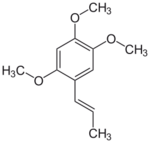 |
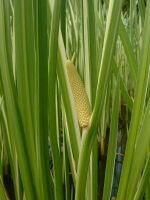 | |
 |
Alchornea floribunda | α2-adrenergic receptor antagonist.[citation needed] |
  |
 |
GABA uptake inhibitor,[108][109] stimulant.[110] |
 |
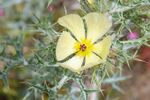
|
Used by Chinese residents of Mexico during the early 20th century as a legal substitute for opium and currently smoked as a marijuana substitute.[citation needed] |
 |
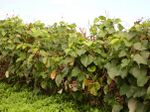
Argyreia nervosa (Hawaiian Baby Woodrose) |
Seeds contain ergine (also known as LSA), often 50-150X the amounts found in Ipomoea violacea. LSA is a hallucinogen.[111] |
 |
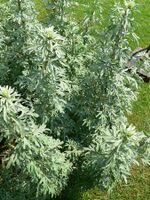 |
Also called "wormwood". GABA receptor antagonist.[112] |
| Quinoline & Aporphine alkaloids |  Asimina triloba (Paw Paw) |
Identical alkaloid to morphine.[113] |
 150px 150px  Tropane alkaloids (scopolamine, atropine, hyoscyamine) |
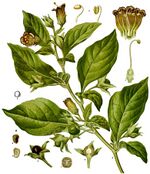 |
Commonly known as 'deadly nightshade'. An anticholinergic deliriant.[114] |
 150px 150px  Tropane alkaloids (scopolamine, atropine, and hyoscyamine) |
 |
Commonly known as 'angel's trumpets'. An anticholinergic deliriant.[114] |
| Unknown | 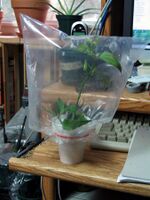
Calea zacatechichi |
Produces vivid dreams after smoking. It is also employed by the Chontal people as a medicinal herb against gastrointestinal disorders, and is used as an appetizer, cathartic anti-dysentery remedy, and as a fever-reducing agent. Its psychedelic properties do not become apparent until the user is asleep. Reports describe rituals that involve drinking it as a tea to induce divinatory or lucid dreams[115] due to its properties as an oneirogen.[116] |
 |
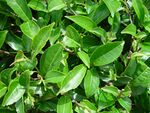 |
Tea leaves, tea, native to Asia.[citation needed] |
 |
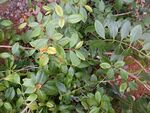
Catha edulis |
Khat, commonly chewed, produces a stimulant effect.[117] |
 |
 |
Catharanthus roseus is (perhaps unpleasantly) "hallucinogenic."[118][unreliable source?] |
| Unknown | 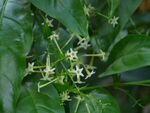 |
Commonly referred to as 'night-blooming jasmine', 'lady of the night', and 'poisonberry'. It has an unknown mechanism of action.[citation needed] |
 |
 |
Coffee beans, coffee, native to Africa.[119] |
 |
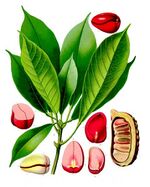 Cola |
Cola or kola nut, traditional additive to cola, native to Africa.[citation needed] |
| (Unknown) | 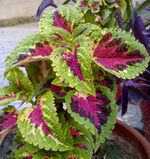
|
Unknown |

|

Corydalis solida, cava |
Bulbocapnine, Nantenine, Tetrahydropalmatine |
  Tropane alkaloids (Scopolamine, Atropine) |
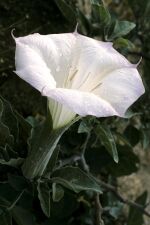
|
Also known as 'thorn apple', 'devil's trumpets', 'loco weed', and 'Jimson weed'. Scopolamine and Atropine are both anticholinergics[120][121] which produce hallucinogenic and deliriant effects. It has an extensive history of being used recreationally.[122] |
 |
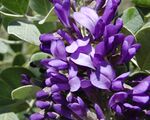 |
Nicotine-like effects. partial agonist of nicotinic acetylcholine receptors (nAChRs).[123] |
| Unknown | 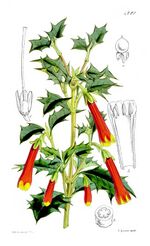 Desfontainia spinosa |
Causes visions.[124] |
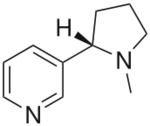 |
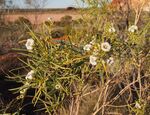 |
Pituri |
| Unknown |  |
African dream herb.[citation needed] |
 |
 |
Ephedra |
 |
 |
Coca. Widely used illegal stimulant, produces hallucination in overdose, native to South America.[citation needed] |
| Unknown |  |
Nerve or mosaic plant, said to produce vision of eyeballs |
 |
Galbulimima belgraveana | Galbulimima belgraveana is rich in alkaloids and twenty-eight alkaloids have been isolated including himbacine.[citation needed] |
 |
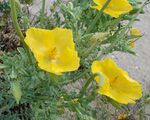
|
Hallucinogenic effects.[125] |
 Possibly Cryogenine[citation needed] |
Heimia myrtifolia | Auditory |
 Possibly Cryogenine[citation needed] |
 |
Auditory[126][better source needed] |
  |
 |
Star of Bethlehem |
 |
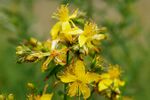 |
Saint John's wort |
| Tropane alkaloids | 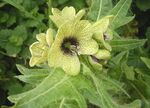 |
Henbane |
  Caffeine, Theobromine, Dimethylxanthines |
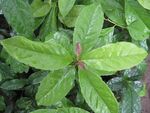 |
Ilex guayusa is used as an additive to some versions of Ayahuasca. According to the Ecuadorian indigenous, it is also slightly hallucinogenic on its own, when drunk in high enough quantities.[citation needed] |
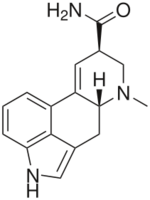 |
 |
Ergine in seeds; up to 0.12% total[127] Produces psychedelic effects. |
| Unknown | 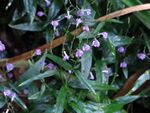 |
Unknown |
| Lactucarium | 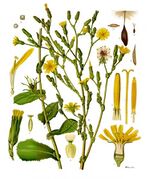
|
Lactucarium |
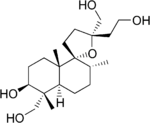
|
 |
Lagochilin is thought to be responsible for the sedative, hypotensive and hemostatic effects of this plant.[citation needed] |
 |

|
Pukateine |
| Unknown | 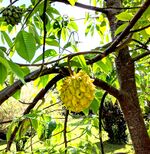 Rollinia mucosa |
Rollinia mucosa is said to be a narcotic.[113] |
 |

|
Both leaves and flowers (where most concentrated) contain Leonurine. (Effects reminiscent of marijuana)[citation needed] |
 |
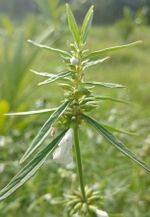 Leucas aspera |
Nicotine |
 |
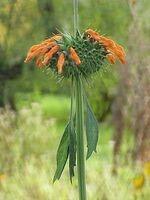
|
Both leaves and flowers (where most concentrated) contain Leonurine and several compounds. (Effects reminiscent of marijuana)[citation needed][129] |
 |
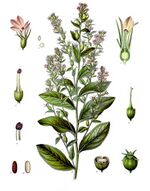 |
Indian tobacco |
| Unknown | 
|
[6] |
 150px 150px  Tropane alkaloids (scopolamine, atropine, and hyoscyamine) |
 |
Mandrake has deliriant and anticholinergic properties.[114] |
 |
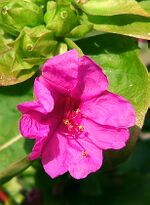 Some Mirabilis spp. |
Possibly contains ergine[citation needed], a hallucinogen. |
  |
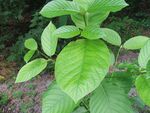 |
Usually referred to as kratom. Has opioid-like and stimulant properties.[130] |
 |
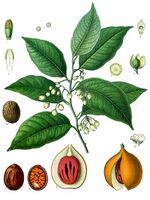 |
Nutmeg |
 |
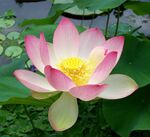 |
Sacred lotus |
 |
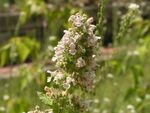 |
Catnip |
 |
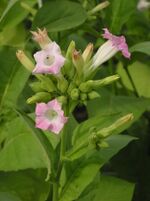 |
Tobacco. Can cause hallucinations in very large doses.[citation needed] |
 |
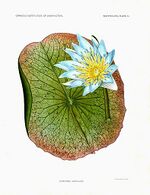
|
Blue lotus or lily. Recent studies have shown Nymphaea caerulea to have psychedelic properties, and may have been used as a sacrament in ancient Egypt and certain ancient South American cultures. Dosages of 5 to 10 grams of the flowers induces slight stimulation, a shift in thought processes, enhanced visual perception, and mild closed-eye visuals.[131] Nymphaea caerulea is related to, and possesses similar activity as Nelumbo nucifera, the Sacred Lotus. Both Nymphaea caerulea and Nelumbo nucifera contain the alkaloids nuciferine and apomorphine, which have been recently isolated by independent labs.[citation needed]
These psychoactive effects make Nymphaea caerulea a likely candidate (among several) for the lotus plant eaten by the mythical Lotophagi in Homer's Odyssey. Used in aromatherapy, Nymphaea caerulea is purported to have a "divine" essence, bringing euphoria, heightened awareness and tranquility.[citation needed] Other sources cite anti-spasmodic and sedative, purifying and calming properties. |
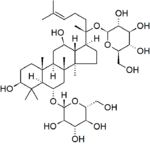 Ginsenosides |
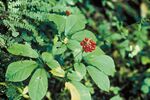 |
Ginseng |
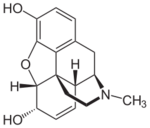 |
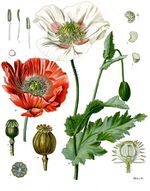 |
Opium. Widely used analgesic, native to the Old World.[132] |
| Unknown | 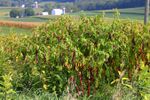 |
Narcotic and toxic when the root is consumed.[113] |
 |
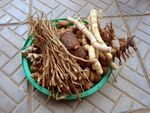 |
α2-adrenergic receptor antagonist.[citation needed] |
| Unknown | 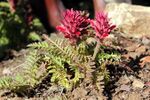 |
Indian warrior |
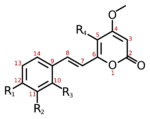 Kavalactones |
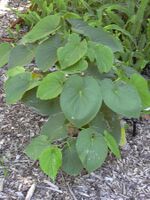
|
An anxiolytic[133] and hypnotic.[134] Often advertised as a 'healthier' alternative to alcohol.[citation needed] |
 |
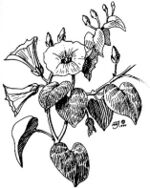 Rivea corymbosa |
Seeds contain ergine, lysergol, and turbicoryn; lysergic acid alkaloids up to 0.03%[135] Has psychedelic properties. |
 |
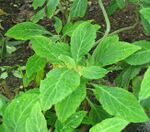
|
Salvinorin A, 0.89–3.87 mg/g, also Salvinorin B and Salvinorin C[136][unreliable source?] |
 Mesembrine |
 |
Kanna[137][138] |
 |
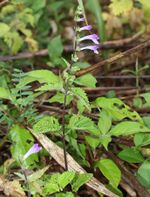 |
Known commonly as 'skullcaps'. Baicalein is a positive allosteric modulator of GABAA receptor.[139] |
| Unknown | 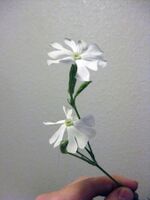
Silene capensis |
Produces vivid dreams after smoking.[140] |
| Unknown | 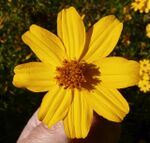
|
Anethole, Chavicol, Coumarin, Estragole, Isorhamnetin, Methyleugenol, Quercitin |
 |
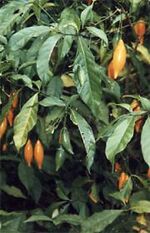
|
Ibogaine in root bark. Produces psychedelic and a dissociative effects.[141][142] |
 |
Tabernanthe orientalis |
Ibogaine in root leaves. Produces psychedelic and a dissociative effects.[141][142] |
  |
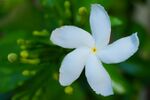
|
Is a psychedelic and a dissociative.[142] |
 |
Tabernanthe pubescens |
Is a psychedelic and a dissociative. Contains ibogaine and similar alkaloids.[141][142] |
 |
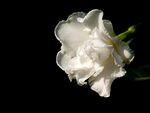 Tabernaemontana sp. |
Is a psychedelic and a dissociative.[141][142] |
 |
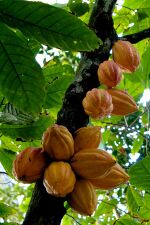 |
Cocoa or cacao bean, chocolate, native to the Americas |
 |

| |
 |
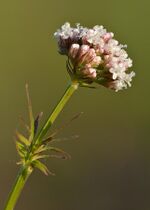 |
Possible sedative and anxiolytic effects. Valerenic acid is GABAA receptor positive allosteric modulator,[143] and a 5-HT5A receptor partial agonist.[144] |
 |
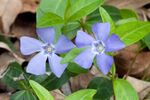 |
Vincamine.[145] |
 |
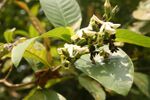 |
Voacangine is similar in structure to ibogaine. It inhibits AChE.[146][147] |
 |
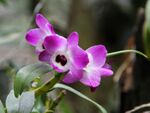 |
Also contains phenanthrenes and dendrobine related alkaloids. |
  |
 |
Zornia latifolia is sometimes combined with synthetic cannabis. It may produce similar effects to cannabis.[149][150] It is nicknamed Maconha brava because locals use it as a cannabis substitute.[citation needed] |
See also
- Aztec entheogenic complex
- Entheogenic drugs and the archaeological record
- God in a Pill?
- Hallucinogenic fish
- Hallucinogenic plants in Chinese herbals
- List of Acacia species known to contain psychoactive alkaloids
- List of entheogenic/hallucinogenic species
- List of plants used for smoking
- List of poisonous plants
- List of psychoactive plants, fungi, and animals
- Louisiana State Act 159
- N,N-Dimethyltryptamine
- Psilocybin mushrooms
- Psychoactive cactus
- Psychoactive plant
Notes
- ↑ Other psychoactive compounds without nitrogen atoms include kavalactones and salvinorins, known from kava and Salvia divinorum, respectively.
References
- ↑ Sayin, H. Umit (2016). "Psychoactive Plants Used during Religious Rituals". Neuropathology of Drug Addictions and Substance Misuse. Elsevier. pp. 17–28. doi:10.1016/b978-0-12-800634-4.00002-0. ISBN 9780128006344.
- ↑ Kohek, Maja; Sánchez Avilés, Constanza; Romaní, Oriol; Bouso, José Carlos (2021). "Ancient psychoactive plants in a global village: The ritual use of cannabis in a self-managed community in Catalonia". International Journal of Drug Policy (Elsevier BV) 98: 103390. doi:10.1016/j.drugpo.2021.103390. ISSN 0955-3959. PMID 34340169.
- ↑ "IJ PACHTER, DE ZACHARIAS, O RIBEIRO – The Journal of Organic Chemistry, 1959 -". Pubs.acs.org. http://pubs.acs.org/cgi-bin/abstract.cgi/joceah/1959/24/i09/f-pdf/f_jo01091a032.pdf?sessid=6006l3.
- ↑ 4.00 4.01 4.02 4.03 4.04 4.05 4.06 4.07 4.08 4.09 4.10 4.11 4.12 "Trout's Notes on Some Other Succulents". http://www.entheogen.com/component/option,com_docman/task,doc_download/gid,6/Itemid,42/.
- ↑ "Profiles of Psychedelic Drugs". paranoia.lycaeum.org. http://paranoia.lycaeum.org/psychedelics/tryptamines/dmt.info.
- ↑ 6.00 6.01 6.02 6.03 6.04 6.05 6.06 6.07 6.08 6.09 6.10 6.11 6.12 6.13 6.14 6.15 6.16 6.17 6.18 6.19 6.20 6.21 6.22 6.23 6.24 6.25 6.26 6.27 6.28 6.29 6.30 6.31 6.32 6.33 6.34 6.35 6.36 6.37 6.38 6.39 6.40 6.41 6.42 6.43 6.44 6.45 6.46 6.47 6.48 6.49 6.50 6.51 6.52 6.53 6.54 6.55 6.56 6.57 6.58 6.59 6.60 6.61 6.62 6.63 6.64 6.65 6.66 6.67 6.68 6.69 6.70 6.71 6.72 6.73 6.74 6.75 6.76 6.77 6.78 6.79 6.80 6.81 6.82 6.83 6.84 6.85 6.86 6.87 Rätsch, Christian (25 April 2005). The Encyclopedia of Psychoactive Plants: Ethnopharmacology and Its Applications. Inner Traditions/Bear. ISBN 9781594776625. https://books.google.com/books?id=Rs5rAwAAQBAJ&q=Magnolia+virginiana+psychoactive&pg=PT2377. Retrieved 22 December 2017.
- ↑ "Isolation, spectral characterization, molecular docking, and cytotoxic activity of alkaloids from Erythroxylum pungens O. E. Shulz". Phytochemistry 155: 12–18. November 2018. doi:10.1016/j.phytochem.2018.07.003. PMID 30056276. Bibcode: 2018PChem.155...12M.
- ↑ 8.0 8.1 8.2 8.3 Glasby, John Stephen (1991). Dictionary of Plants Containing Secondary Metabolites. CRC Press. p. 2. ISBN 978-0-85066-423-2. https://books.google.com/books?id=te53VV5u8YMC&q=acacia+alkaloids&pg=RA1-PA2.
- ↑ Nutritive value assessment of the tropical shrub legume Acacia angustissima: anti-nutritional compounds and in vitro digestibility. Personal Authors: McSweeney, C. S., Krause, D. O., Palmer, B., Gough, J., Conlan, L. L., Hegarty, M. P.Author Affiliation: CSIRO Livestock Industries, Long Pocket Laboratories, 120 Meiers Road, Indooroopilly, Qld 4068, Australia. Document Title: Animal Feed Science and Technology, 2005 (Vol. 121) (No. 1/2) 175–190
- ↑ "Maya Ethnobotanicals – Ayahuasca, Rainforest Plants, Folklore, Incenses, Art & Visions". http://www.maya-ethnobotanicals.com/product_info.phtml/herbid_340/category_ayahuasca.
- ↑ 11.0 11.1 11.2 11.3 11.4 11.5 11.6 11.7 Black Panther. "Akacje". Herbarium.0–700.pl. http://herbarium.0-700.pl/Akacje.html.
- ↑ "Lycaeum > Leda > Acacia auriculiformis". Leda.lycaeum.org. http://leda.lycaeum.org/?ID=15931.
- ↑ 13.0 13.1 13.2 13.3 13.4 13.5 13.6 Hegnauer, R. (1996-07-30). Caesalpinioideae und Mimosoideae. Springer. ISBN 9783764351656. https://books.google.com/books?id=YpnboQBbw7EC&q=acacia+tryptamine&pg=PA336. Retrieved 14 January 2015.
- ↑ 14.0 14.1 14.2 14.3 Australian Bush Food and Native Medicine Forum members. "Australian Bushfood (Bushtucker) and Native Medicine Forum". Bushfood.net. http://www.bushfood.net/viewtopic.php?p=3443.
- ↑ "Entheology.org – Preserving Ancient Knowledge". Entheology.org. http://www.entheology.org/edoto/anmviewer.asp?a=47.
- ↑ "Ask Dr. Shulgin Online September 26, 2001". Cognitiveliberty.org. http://www.cognitiveliberty.org/shulgin/adsarchive/acacia.htm.
- ↑ "Dr Karl's Q&A forum". Abc.net.au. http://www.abc.net.au/science/k2/stn/q&a/notes/051027-9.htm.
- ↑ "comp phyto". Users.lycaeum.org. http://users.lycaeum.org/~mulga/acacia/comphy.html.
- ↑ "acacias and entheogens". Users.lycaeum.org. http://users.lycaeum.org/~mulga/acacia/entheo.html.
- ↑ "Lycaeum > Leda > Acacia complanata". Users.lycaeum.org. http://leda.lycaeum.org/?ID=15796.
- ↑ 21.00 21.01 21.02 21.03 21.04 21.05 21.06 21.07 21.08 21.09 21.10 21.11 21.12 21.13 Cite error: Invalid
<ref>tag; no text was provided for refs namedshaman - ↑ NMR spectral assignments of a new chlorotryptamine alkaloid and its analogues from Acacia confusa Malcolm S. Buchanan, Anthony R. Carroll, David Pass, Ronald J. Quinn Magnetic Resonance in Chemistry Volume 45, Issue 4, pp. 359–361. John Wiley & Sons, Ltd.
- ↑ "Naturheilpraxis – Fachforum – Die Heilkraft der Akazien – Ein einführender Überblick". 5 January 2010. http://www.naturheilpraxis.de/exclusiv/nh-online/2005/nhp05/a_nh-ff02.html.
- ↑ "Lycaeum > Leda > Acacia cultriformis". Leda.lycaeum.org. http://leda.lycaeum.org/?ID=15965.
- ↑ 25.0 25.1 25.2 "Plant Choices – Phytochemeco Databases". Ars-grin.gov. http://www.ars-grin.gov/duke/plants.html.
- ↑ 26.0 26.1 Vivid Interactive and Design. "Wattle Seed Workshop Proceedings". http://www.rirdc.gov.au/reports/AFT/03-024.pdf.
- ↑ "www.bpi.da.gov.ph". http://www.bpi.da.gov.ph/Publications/mp/pdf/a/aroma.pdf.
- ↑ "Acacia farnesiana". Hort.purdue.edu. http://www.hort.purdue.edu/newcrop/duke_energy/Acacia_farnesiana.html.
- ↑ 29.0 29.1 29.2 Hegnauer, Robert (1994). Chemotaxonomie der Pflanzen. Springer. p. 500. ISBN 978-3-7643-2979-2. https://books.google.com/books?id=9fDv1RYqIRkC&q=chemotaxonomie+der+pflanzen.
- ↑ "Lycaeum > Leda > Acacia floribunda". leda.lycaeum.org. http://leda.lycaeum.org/?ID=16001.
- ↑ Voogelbreinder, S. "Garden Of Eden" 2009
- ↑ 32.0 32.1 32.2 "Lista över hallucinogena växter, svampar och djur". Wiki.magiskamolekyler.org. http://wiki.magiskamolekyler.org/index.php?title=Lista_%c3%b6ver_hallucinogena_v%c3%a4xter,_svampar_och_djur.
- ↑ "Lycaeum > Leda > Acacia longifolia". leda.lycaeum.org. http://leda.lycaeum.org/?ID=15799.
- ↑ extentech.sheetster.com[yes|permanent dead link|dead link}}]
- ↑ S. Voogelbreinder "Garden Of Eden" 2009
- ↑ "Lista över hallucinogena växter, svampar och djur – Magiska Molekylers Wiki". http://wiki.magiskamolekyler.org/Lista_%C3%B6ver_hallucinogena_v%C3%A4xter,_svampar_och_djur.
- ↑ "obtusifolia phyto". Users.lycaeum.org. http://users.lycaeum.org/~mulga/acacia/obtuphy.html.
- ↑ Plants Containing DMT (German)
- ↑ "Acacia campylacantha – Hortipedia". www.hortipedia.org. http://www.hortipedia.org/de/index.php?title=Acacia_campylacantha.
- ↑ Pawar, RS; Grundel, E; Fardin-Kia, AR; Rader, JI (January 2014). "Determination of selected biogenic amines in Acacia rigidula plant materials and dietary supplements using LC-MS/MS methods.". Journal of Pharmaceutical and Biomedical Analysis 88: 457–66. doi:10.1016/j.jpba.2013.09.012. PMID 24176750.
- ↑ "Chemistry of Acacias from South Texas". http://uvalde.tamu.edu/pdf/chemtdaf.pdf.
- ↑ "Eins". Factorey.ch. http://www.factorey.ch/Eins.htm.
- ↑ 43.0 43.1 43.2 43.3 43.4 43.5 Granier-Doyeux, Marcel (January 1, 1965). "Native hallucinogenic drugs piptadenias". United Nations Office on Drugs and Crime. http://www.unodc.org/unodc/en/bulletin/bulletin_1965-01-01_2_page006.html?print=yes.
- ↑ 44.0 44.1 44.2 44.3 44.4 44.5 44.6 44.7 Dr. Duke's Phytochemical and Ethnobotanical Databases
- ↑ "Cultivo de Curupay, Cebil colorado (Anadenanthera colubrina) y usos, herbotecnia". Herbotecnia.com.ar. http://www.herbotecnia.com.ar/aut-curupay.html.
- ↑ "Bufo alvarius – Jonathan Ott on Bufotenine". Erowid.org. http://www.erowid.org/archive/sonoran_desert_toad/ott.htm.
- ↑ Dr. Duke's Phytochemical and Ethnobotanical Databases
- ↑ Stafford, Peter (2013-02-18). Psychedelics Encyclopedia. Ronin. ISBN 9781579511692. https://books.google.com/books?id=Ec5hNgYWHtkC&q=%22dmt+n+oxide%22&pg=RA2-PA313. Retrieved 14 January 2015.
- ↑ Ott, J. (July–September 2001). "Pharmañopo-psychonautics: human intranasal, sublingual, intrarectal, pulmonary and oral pharmacology of bufotenine". Journal of Psychoactive Drugs 33 (3): 273–81. doi:10.1080/02791072.2001.10400574. PMID 11718320.
- ↑ 50.0 50.1 "Erowid Online Books : "Ayahuasca: alkaloids, plants, and analogs" by Keeper of the Trout". Erowid.org. http://www.erowid.org/library/books_online/ayahuasca_apa/aya_sec3_part2_desmanthus.shtml.
- ↑ Hegnauer, R. (1996-07-30). Google Book Search. Springer. ISBN 978-3-7643-5165-6. https://books.google.com/books?id=bUV8C6iLFkEC&q=%22Mimosa+somnians%22&pg=PA236. Retrieved 2008-05-08.
- ↑ {{citation | mode = cs1 | title = Desmodium caudatum | work = Germplasm Resources Information Network (GRIN) | url = https://npgsweb.ars-grin.gov/gringlobal/taxonomydetail.aspx?311307 | publisher = [[Organization:Agricultural Research ServAgricultural Research Service (ARS), United States Department of Agriculture (USDA) | access-date = 2008-05-02 }}
- ↑ 53.0 53.1 53.2 "Trout's Notes on Desmodium". http://trout.yage.net/sc/D2_2004_Trout.pdf.
- ↑ 54.0 54.1 54.2 54.3 54.4 54.5 54.6 54.7 54.8 "Erowid Psychoactive Vaults : Tryptamine FAQ". Erowid.org. http://www.erowid.org/psychoactives/faqs/faqs_tryptamine.shtml.
- ↑ "Isolation and Identification of Putative Hallucinogenic Constituents from the Roots of Mimosa ophthalmocentra". Pharmaceutical Biology.
- ↑ Hegnauer, R. (1996-07-30). Google Book Search. Springer. ISBN 978-3-7643-5165-6. https://books.google.com/books?id=bUV8C6iLFkEC&q=%22Mimosa+somnians%22&pg=PA236. Retrieved 2008-05-07.
- ↑ "Ask Erowid : ID 75 : What is the DMT content of Mimosa hostilis rootbark?". Erowid.org. http://www.erowid.org/ask/ask.php?ID=75.
- ↑ "UNODC Bulletin on Narcotics 1969". http://www.unodc.org/unodc/en/bulletin/bulletin_1969-01-01_4_page004.html.
- ↑ Dart, Richard C. (2004). Medical Toxicology - Google Book Search. Lippincott Williams & Wilkins. ISBN 978-0-7817-2845-4. https://books.google.com/books?id=qDf3AO8nILoC&q=%22mucuna+pruriens%22+alkaloids&pg=PA1679. Retrieved 2008-03-15.
- ↑ 60.0 60.1 60.2 60.3 60.4 "tryptamines: fungi". Bluezoo.org. http://bluezoo.org/tryptamines/plants.html.
- ↑ 61.0 61.1 61.2 61.3 61.4 61.5 61.6 61.7 61.8 [1][yes|permanent dead link|dead link}}]
- ↑ Ott, Jonathan (1996). Pharmacotheon. Natural Products Company. p. 219. ISBN 9780961423483. https://archive.org/details/pharmacotheonent00ottj.
- ↑ "Species Information". sun.ars-grin.gov. http://sun.ars-grin.gov:8080/npgspub/xsql/duke/plantdisp.xsql?taxon=1065.
- ↑ 64.0 64.1 "5-MeO-DMT". Tryptamines.com. http://www.tryptamines.com/.
- ↑ "Committee for veterinary medicinal products virola sebifera summary report". http://www.emea.europa.eu/pdfs/vet/mrls/060499en.pdf.
- ↑ Peter R. Cheeke (1989). Toxicants of Plant Origin. CRC-Press. p. 169. ISBN 978-0-8493-6990-2. https://books.google.com/books?id=eASgQyXq8xMC&q=%22mimosa+hostilis%22+dimethyltryptamine&pg=PA169. Retrieved 2008-04-20.
- ↑ "Erowid Arundo donax Vaults : Trout's Notes on Tryptamine Content of Arundo donax". Erowid.org. http://www.erowid.org/plants/arundo_donax/arundo_donax_info1.shtml.
- ↑ 68.0 68.1 68.2 "DMT, Life and the Universe". Nepenthes.lycaeum.org. http://nepenthes.lycaeum.org/Plants/Phalaris/DMTLU.html.
- ↑ 69.0 69.1 69.2 "Erowid Phalaris Vault : FAQ 2.01". Erowid.org. http://www.erowid.org/plants/phalaris/phalaris_faq.shtml.
- ↑ Wassel, G. M.; El-Difrawy, S.M.; Saeed, A.A. (1985). "Alkaloids from the Rhizomes of Phragmites australis Cav.". Scientia Pharmaceutica 53: 169–170.
- ↑ Rivier, Laurent; Lindgren, Jan-Erik (1972). ""Ayahuasca," the South American Hallucinogenic Drink: An Ethnobotanical and Chemical Investigation". Economic Botany 26 (2): 101–129. doi:10.1007/BF02860772. ISSN 0013-0001. https://www.jstor.org/stable/4253328.
- ↑ "Psychotria – The Most Important Genera and Species from A to Z – The Encyclopedia of Psychoactive Plants: Ethnopharmacology and Its Applications". https://doctorlib.info/herbal/encyclopedia-psychoactive-plants-ethnopharmacology/93.html.
- ↑ "Psychotria poeppigiana – Uragoga tomentosa". Discover Life. http://www.discoverlife.org/mp/20q?search=Psychotria+poeppigiana.
- ↑ "Amazing Nature". Amazing-nature.com. http://www.amazing-nature.com/-i-36.html?osCsid=38ad41e62a454589a0afd2d17ae0fa40.
- ↑ Servillo, L; Giovane, A; Balestrieri, ML; Cautela, D; Castaldo, D (Sep 2012). "N-methylated tryptamine derivatives in citrus genus plants: identification of N,N,N-trimethyltryptamine in bergamot". Journal of Agricultural and Food Chemistry 60 (37): 9512–8. doi:10.1021/jf302767e. PMID 22957740.
- ↑ Servillo, L; Giovane, A; Balestrieri, ML; Casale, R; Cautela, D; Castaldo, D (May 2013). "Citrus genus plants contain N-methylated tryptamine derivatives and their 5-hydroxylated forms". Journal of Agricultural and Food Chemistry 61 (21): 5156–62. doi:10.1021/jf401448q. PMID 23682903.
- ↑ Santos, Ana Paula; Moreno, Paulo Roberto Hrihorowitsch (Jun 2004). "Pilocarpus spp.: A survey of its chemical constituents and biologicalactivities". Brazilian Journal of Pharmaceutical Sciences 40 (2): 116–137. doi:10.1590/S1516-93322004000200002.
- ↑ 78.0 78.1 78.2 "Citrus Growers Manufacture Huge Amounts of DMT". https://the-nexian.me/home/knowledge/112-citrus-growers-manufacture-huge-amounts-of-dmt.
- ↑ 79.0 79.1 79.2 79.3 79.4 79.5 "Citrus Genus Plants Contain N-Methylated Tryptamine Derivatives and Their 5-Hydroxylated Forms". https://www.researchgate.net/publication/236917343.
- ↑ 80.0 80.1 80.2 "CitrusGenus Plants Contain N‑Methylated Tryptamine Derivativesand Their 5‑Hydroxylated Forms". http://diyhpl.us/~nmz787/pdf/Citrus_Genus_Plants_Contain_N-Methylated_Tryptamine_Derivatives_and_Their_5-Hydroxylated_Forms.pdf.
- ↑ Meyer, B. N.; Helfrich, J. S.; Nichols, D. E.; McLaughlin, J. L.; Davis, D. V.; Cooks, R. G. (1983). "Cactus Alkaloids. LIII. Coryphanthine and O-Methyl-Candicine, Two New Quaternary Alkaloids from Coryphantha greenwoodii". Journal of Natural Products 46 (5): 688–693. doi:10.1021/np50029a017.
- ↑ N. Meyer, B; S. Helfrich, J; Nichols, David; L. McLaughlin, J; V. Davis, D; G. Cooks, R (1 July 2004). "Cactus Alkaloids. LIII. Coryphanthine and O-Methyl-Candicine, Two New Quaternary Alkaloids from Coryphantha greenwoodii". Journal of Natural Products 46 (5): 688–693. doi:10.1021/np50029a017. https://www.researchgate.net/publication/231715448. Retrieved 22 December 2017.
- ↑ 83.0 83.1 83.2 83.3 83.4 83.5 "Descriptions of psychoactive Cacti.". Users.lycaeum.org. http://users.lycaeum.org/~iamklaus/botany.htm#.
- ↑ "Cane Cholla (Cylindropuntia spinosior )". Desert-tropicals.com. http://www.desert-tropicals.com/Plants/Cactaceae/Opuntia_spinosior.html.
- ↑ "Partial List of Alkaloids in Trichocereus Cacti". Thenook.org. http://www.thenook.org/archives/tek/alklist.htm.
- ↑ a1b2c3.com. "Trichocereus spp. Information". A1b2c3.com. http://www.a1b2c3.com/drugs/var014.htm.
- ↑ 87.0 87.1 87.2 "Partial List of Alkaloids in Trichocereus Cacti". Thennok.org. http://www.thenook.org/archives/tek/alklist.htm.
- ↑ 88.0 88.1 88.2 88.3 Forbidden Fruit Archives
- ↑ "Echinopsis tacaquirensis ssp. taquimbalensis". Desert-tropicals.com. http://www.desert-tropicals.com/Plants/Cactaceae/Echinopsis_taquimb.html.
- ↑ "Cardon Grande (Echinopsis terscheckii)". Desert-tropicals.com. http://www.desert-tropicals.com/Plants/Cactaceae/Echinopsis_terscheckii.html.
- ↑ 91.0 91.1 91.2 "Erowid Cacti Vaults : Visionary Cactus Guide – Mescaline from Sawdust". Erowid.org. http://www.erowid.org/plants/cacti/cacti_guide/cacti_guide_lophopho.shtml.
- ↑ "Archived copy". http://users.lycaeum.org/~iamklaus/opuntia.htm.
- ↑ "From the behavioral pharmacology of beta-carbolines to seizures, anxiety, and memory". ScientificWorldJournal 7: 204–23. 2007. doi:10.1100/tsw.2007.48. PMID 17334612.
- ↑ 94.00 94.01 94.02 94.03 94.04 94.05 94.06 94.07 94.08 94.09 94.10 94.11 94.12 94.13 94.14 94.15 94.16 94.17 94.18 94.19 94.20 94.21 94.22 94.23 94.24 94.25 94.26 94.27 94.28 94.29 94.30 94.31 94.32 94.33 94.34 94.35 94.36 94.37 94.38 94.39 94.40 94.41 94.42 94.43 94.44 94.45 94.46 94.47 94.48 94.49 94.50 94.51 94.52 94.53 "Cornell University Department of Animal Science". Ansci.cornell.edu. http://www.ansci.cornell.edu/plants/toxicagents/betacarbolines/bcarbfams.html.
- ↑ Callaway, JC; Brito, GS; Neves, ES (2005). "Phytochemical analyses of Banisteriopsis caapi and Psychotria viridis". Journal of Psychoactive Drugs 37 (2): 145–150. doi:10.1080/02791072.2005.10399795. PMID 16149327.
- ↑ Glasby, J. S. (2002-09-11). Directory Of Plants Containing Secondary Metabolites. CRC Press. ISBN 9780203489871. https://books.google.com/books?id=te53VV5u8YMC&q=erythrina+alkaloids&pg=RA1-PA124. Retrieved 14 January 2015.
- ↑ "Chemical Information". sun.ars-grin.gov. http://sun.ars-grin.gov:8080/npgspub/xsql/duke/chemdisp.xsql.
- ↑ 98.0 98.1 "Passion Flower". Drugs.com. https://www.drugs.com/npp/passion-flower.html.
- ↑ "www.amazing-nature.com". http://www.amazing-nature.com/-i-43.html.
- ↑ Ma, ZZ; Hano, Y; Nomura, T; Chen, YJ (April 2000). "Alkaloids and phenylpropanoids from Peganum nigellastrum". Phytochemistry 53 (8): 1075–8. doi:10.1016/S0031-9422(99)00440-9. PMID 10820833. Bibcode: 2000PChem..53.1075M. http://proxify.com/p/011010A1000110/687474703a2f2f7777772e736369656e63656469726563742e636f6d2f736369656e63653f5f6f623d41727469636c6555524c265f7564693d42365448372d343031484747542d3152265f757365723d3130265f72646f633d31265f666d743d265f6f7269673d736561726368265f736f72743d6426766965773d63265f616363743d43303030303530323231265f76657273696f6e3d31265f75726c56657273696f6e3d30265f7573657269643d3130266d64353d6631346535636632633161653335346164393536316232336262646533643236. Retrieved 2008-01-12.
- ↑ "Antinociceptive effect of 7-hydroxymitragynine in mice: Discovery of an orally active opioid analgesic from the Thai medicinal herb Mitragyna speciosa". Life Sciences 74 (17): 2143–2155. March 2004. doi:10.1016/j.lfs.2003.09.054. PMID 14969718.
- ↑ Menzies, John R.W; Paterson, Stewart J.; Duwiejua, Mahama; Corbett, Alistair D. (1998). "Opioid activity of alkaloids extracted from Picralima nitida (Fam. Apocynaceae)". European Journal of Pharmacology 350 (1): 101–108. doi:10.1016/s0014-2999(98)00232-5. PMID 9683021.
- ↑ "Detection of pericine, a new CNS-active indole alkaloid from Picralima nitida cell suspension culture by opiate receptor binding studies". Planta Medica 46 (4): 210–4. December 1982. doi:10.1055/s-2007-971216. PMID 6298847.
- ↑ Alkaloids: Biochemistry, Ecology, and Medicinal Applications. Springer. 30 June 1998. pp. 68–69. ISBN 978-0-306-45465-3.
- ↑ "Pyrrolidinoindoline Alkaloids from Psychotria colorata1". Journal of Natural Products 61 (3): 392–6. March 1998. doi:10.1021/np9701642. PMID 9548883.
- ↑ "Antinociceptive profile of hodgkinsine". Planta Medica 66 (8): 770–2. December 2000. doi:10.1055/s-2000-9604. PMID 11199142.
- ↑ Mitaine, A. C.; Mesbah, K; Richard, B; Petermann, C; Arrazola, S; Moretti, C; Zèches-Hanrot, M; Men-Olivier, L. L. (1996). "Alkaloids from Aspidosperma species from Bolivia". Planta Medica 62 (5): 458–61. doi:10.1055/s-2006-957939. PMID 17252481.
- ↑ Voigt, V; Laug, L; Zebisch, K; Thondorf, I; Markwardt, F; Brandsch, M (2013). "Transport of the areca nut alkaloid arecaidine by the human proton-coupled amino acid transporter 1 (hPAT1)". The Journal of Pharmacy and Pharmacology 65 (4): 582–90. doi:10.1111/jphp.12006. PMID 23488788.
- ↑ Johnston, G. A. R.; Krogsgaard-Larsen, P.; Stephanson, A. (1975). "Betel nut constituents as inhibitors of γ-aminobutyric acid uptake". Nature 258 (5536): 627–628. doi:10.1038/258627a0. ISSN 0028-0836. PMID 1207742. Bibcode: 1975Natur.258..627J. https://ui.adsabs.harvard.edu/abs/1975Natur.258..627J/abstract.
- ↑ "Arecoline M1 receptor activation is a requirement for arecoline analgesia". Il Farmaco 56 (5–7): 383–5. 2001. doi:10.1016/S0014-827X(01)01091-6. PMID 11482763.
- ↑ Halpern, J.H. (2004). "Hallucinogens and dissociative agents naturally growing in the United States". Pharmacology & Therapeutics 102 (2): 131–138. doi:10.1016/j.pharmthera.2004.03.003. PMID 15163594. "Although LSD does not occur in nature, a close analogue, lysergic acid amide (LSA, ‘‘ergine’’) is found in the seeds of Argyreia nervosa (Hawaiian baby woodrose)".
- ↑ Olsen, Richard W. (2000-04-25). "Absinthe and γ-aminobutyric acid receptors". Proceedings of the National Academy of Sciences of the United States of America 97 (9): 4417–4418. doi:10.1073/pnas.97.9.4417. ISSN 0027-8424. PMID 10781032. Bibcode: 2000PNAS...97.4417O.
- ↑ 113.0 113.1 113.2 Denise Otsuka, Rafaela; Otsuka, Rafaela Denise; Lago, Joao Henrique Ghilardi; Rossi, Lucia; Galduroz, Jose Carlos Fernandes; Rodrigues, Eliana (2010). "Psychoactive Plants Described in a Brazilian Literary Work and their Chemical Compounds". Central Nervous System Agents in Medicinal Chemistry 10 (3): 218–237. doi:10.2174/1871524911006030218. PMID 20557283. https://www.academia.edu/1103613.
- ↑ 114.0 114.1 114.2 Kennedy, David O. (2014). "The Deliriants – The Nightshade (Solanaceae) Family". Plants and the Human Brain. New York City: Oxford University Press. pp. 131–137. ISBN 9780199914012. https://books.google.com/books?id=YUNDAgAAQBAJ&pg=PA131.
- ↑ "lucid dreams". https://dreamifiel.com/blog/lucid-dreams/.
- ↑ Sałaga, Maciej; Fichna, Jakub; Socała, Katarzyna; Nieoczym, Dorota; Pieróg, Mateusz; Zielińska, Marta; Kowalczuk, Anna; Wlaź, Piotr (2016). "Neuropharmacological characterization of the oneirogenic Mexican plant Calea zacatechichi aqueous extract in mice". Metabolic Brain Disease 31 (3): 631–641. doi:10.1007/s11011-016-9794-1. ISSN 0885-7490. PMID 26821073.
- ↑ Al Zarouni, Yousif (2015). The Effects of Khat (Catha Edulis) (First ed.). London: Yousif Al Zarouni. pp. 5. ISBN 978-1-326-24867-3.
- ↑ "Protected Blog". Sliceoftheday. http://sliceoftheday.wordpress.com/2007/05/13/madagascar-periwinkle-catharanthus-roseus/.[|permanent dead link|dead link}}]
- ↑ Silvarolla, Maria B.; Mazzafera, Paulo; Fazuoli, Luiz C. (2004). "Plant biochemistry: A naturally decaffeinated arabica coffee". Nature 429 (6994): 826. doi:10.1038/429826a. PMID 15215853. Bibcode: 2004Natur.429..826S.
- ↑ "Atropine". The American Society of Health-System Pharmacists. https://www.drugs.com/monograph/atropine.html.
- ↑ Osbourn, Anne E.; Lanzotti, Virginia (2009). Plant-derived Natural Products: Synthesis, Function, and Application. Springer Science & Business Media. p. 5. ISBN 9780387854984. https://books.google.com/books?id=Y8SpVXEng4QC&pg=PA6.
- ↑ Fatur, Karsten (7 January 2021). "Peculiar plants and fantastic fungi: An ethnobotanical study of the use of hallucinogenic plants and mushrooms in Slovenia". PLOS ONE 16 (1): e0245022. doi:10.1371/journal.pone.0245022. PMID 33412556. Bibcode: 2021PLoSO..1645022F.
- ↑ Dallanoce, Clelia; Frigerio, Fabio; Martelli, Giuliana; Grazioso, Giovanni; Matera, Carlo; Pomè, Diego Yuri et al. (2010). "Novel tricyclic Δ2-isoxazoline and 3-oxo-2-methyl-isoxazolidine derivatives: Synthesis and binding affinity at neuronal nicotinic acetylcholine receptor subtypes". Bioorganic & Medicinal Chemistry 18 (12): 4498–4508. doi:10.1016/j.bmc.2010.04.065. ISSN 0968-0896. PMID 20478710.
- ↑ Schultes, Richard Evans, Iconography of New World Plant Hallucinogens. p. 101
- ↑ Rovinskiĭ VI (Sep 1989). "A case of hallucinogen-like action of glaucine. (Russian)". Klinicheskaia Meditsina (Mosk) 67 (9): 107–8. PMID 2586025.
- ↑ "Erowid Sinicuichi Vault : FAQ (heimia salicifolia Frequently Asked Questions)". Erowid.org. http://www.erowid.org/plants/sinicuichi/sinicuichi_faq.shtml.
- ↑ "Trichterwinde (Ipomoea violacea) im GIFTPFLANZEN.COMpendium". Giftpflanzen.com. http://www.giftpflanzen.com/ipomoea_violacea.html.
- ↑ Mangathayaru, K; Thirumurugan, D; Patel, PS; Pratap, DV.V; David, DJ; Karthikeyan, J (2006). "Isolation and identification of nicotine from leucas aspera (willd) link". Indian Journal of Pharmaceutical Sciences 68 (1): 88. doi:10.4103/0250-474X.22972. ISSN 0250-474X.
- ↑ Hunter, E.; Stander, M.; Kossmann, J.; Chakraborty, S.; Prince, S.; Peters, S.; Loedolff, Bianke (2020-11-10). "Toward the identification of a phytocannabinoid-like compound in the flowers of a South African medicinal plant (Leonotis leonurus)". BMC Research Notes 13 (1): 522. doi:10.1186/s13104-020-05372-z. ISSN 1756-0500. PMID 33172494.
- ↑ Eastlack, Steven C.; Cornett, Elyse M.; Kaye, Alan D. (2020). "Kratom—Pharmacology, Clinical Implications, and Outlook: A Comprehensive Review". Pain and Therapy 9 (1): 55–69. doi:10.1007/s40122-020-00151-x. ISSN 2193-8237. PMID 31994019.
- ↑ Seligman, Sian (2023-01-13). "Blue Lotus Flower: Smoking, Tea & More" (in en-US). https://doubleblindmag.com/blue-lotus/.
- ↑ "Opium definition". Drugs.com. https://www.drugs.com/dict/opium.html.
- ↑ Pittler MH, Ernst E (2003). Pittler, Max H. ed. "Kava extract for treating anxiety". Cochrane Database of Systematic Reviews (1): CD003383. doi:10.1002/14651858.CD003383. PMID 12535473. PMC 6999799. http://www.cochrane.org/CD003383/DEPRESSN_kava-extract-for-treating-anxiety.
- ↑ Baker, Jonathan D. (2011-06-01). "Tradition and toxicity: evidential cultures in the kava safety debate". Social Studies of Science 41 (3): 361–384. doi:10.1177/0306312710395341. ISSN 0306-3127. PMID 21879526.
- ↑ "Ololiuqui (Rivea corymbosa) im GIFTPFLANZEN.COMpendium". Giftpflanzen.com. http://www.giftpflanzen.com/rivea_corymbosa.html.
- ↑ "Salvia divinorum Clones". Sagewisdom.org. http://www.sagewisdom.org/clones.html.[|permanent dead link|dead link}}]
- ↑ Coetzee, Dirk D.; López, Víctor; Smith, Carine (2016-01-11). "High-mesembrine Sceletium extract (Trimesemine™) is a monoamine releasing agent, rather than only a selective serotonin reuptake inhibitor" (in en). Journal of Ethnopharmacology 177: 111–116. doi:10.1016/j.jep.2015.11.034. ISSN 0378-8741. PMID 26615766. https://www.sciencedirect.com/science/article/pii/S0378874115302348.
- ↑ Manganyi, Madira Coutlyne; Bezuidenhout, Cornelius Carlos; Regnier, Thierry; Ateba, Collins Njie (2021-04-28). "A Chewable Cure "Kanna": Biological and Pharmaceutical Properties of Sceletium tortuosum". Molecules (Basel, Switzerland) 26 (9): 2557. doi:10.3390/molecules26092557. ISSN 1420-3049. PMID 33924742.
- ↑ "Interaction of flavones from the roots of Scutellaria baicalensis with the benzodiazepine site". Planta Med. 66 (1): 91–3. 2000. doi:10.1055/s-0029-1243121. PMID 10705749.
- ↑ J. F. Sobiecki (2008). "A review of plants used in divination in southern Africa and their psychoactive effects". Southern African Humanities 20: 333–351.
- ↑ 141.0 141.1 141.2 141.3 "Erowid Online Books : "TIHKAL" – #25 IBOGAINE". Erowid.org. http://www.erowid.org/library/books_online/tihkal/tihkal25.shtml.
- ↑ 142.0 142.1 142.2 142.3 142.4 "Quantification of Anti-Addictive Alkaloids Ibogaine and Voacangine in In Vivo- and In Vitro-Grown Plants of Two Mexican Tabernaemontana Species". Chemistry & Biodiversity 13 (12): 1730–1737. December 2016. doi:10.1002/cbdv.201600146. PMID 27448833.
- ↑ "Identification of the putative binding pocket of valerenic acid on GABAA receptors using docking studies and site-directed mutagenesis". Br. J. Pharmacol. 172 (22): 5403–13. 2015. doi:10.1111/bph.13329. PMID 26375408.
- ↑ Dietz, B.; Mahady, G.; Pauli, G.; Farnsworth, N. (2005). "Valerian extract and valerenic acid are partial agonists of the 5-HT receptor in vitro". Molecular Brain Research 138 (2): 191–197. doi:10.1016/j.molbrainres.2005.04.009. PMID 15921820.
- ↑ Khanavi, M.; Pourmoslemi, S.; Farahanikia, B.; Hadjiakhoondi, A.; Ostad, S. N. (2010). "Cytotoxicity ofVinca minor". Pharmaceutical Biology 48 (1): 96–100. doi:10.3109/13880200903046187. PMID 20645762.
- ↑ "Two fast screening methods (GC-MS and TLC-ChEI assay) for rapid evaluation of potential anticholinesterasic indole alkaloids in complex mixtures". Annals of the Brazilian Academy of Sciences 80 (3): 419–426. 2008. doi:10.1590/s0001-37652008000300003. ISSN 0001-3765. PMID 18797794. https://www.scielo.br/pdf/aabc/v80n3/a03v80n3.pdf.
- ↑ "Indole alkaloids from Tabernaemontana australis (Muell. Arg) Miers that inhibit acetylcholinesterase enzyme". Bioorganic & Medicinal Chemistry 13 (12): 4092–5. June 2005. doi:10.1016/j.bmc.2005.03.045. PMID 15911323.
- ↑ Duke, James A. (2017-10-24). Handbook of Phytochemical Constituent Grass, Herbs and Other Economic Plants: Herbal Reference Library (2 ed.). New York: Routledge. ISBN 978-0-203-75262-3.
- ↑ Cornara, L.; Fortuna-Perez, A. P.; Bruni, I.; Salis, A.; Damonte, G.; Borghesi, B.; Clericuzio, M. (2018-09-01). "Zornia latifolia: a smart drug being adulterated by Stylosanthes guianensis" (in en). International Journal of Legal Medicine 132 (5): 1321–1331. doi:10.1007/s00414-018-1774-z. ISSN 1437-1596. PMID 29362872.
- ↑ Fattore, Liana; Fratta, Walter (2011). "Beyond THC: The New Generation of Cannabinoid Designer Drugs". Frontiers in Behavioral Neuroscience 5: 60. doi:10.3389/fnbeh.2011.00060. ISSN 1662-5153. PMID 22007163.
Bibliography
- Al Zarouni, Yousif (2015). The Effects of Khat (Catha Edulis). London: Yousif Al Zarouni.
External links
- Descriptions of psychoactive Cacti. Lycaeum Visionary Cactus Guide
- Erowid Tryptamine FAQ – More Plants Containing Tryptamines
- John Stephen Glasby, Dictionary of Plants Containing Secondary Metabolites, Published by CRC Press
- Golden Guide to Hallucinogenic Plants
- Hallucinogens on the Internet: A Vast New Source of Underground Drug Information John H. Halpern, M.D. and Harrison G. Pope, Jr., M.D.
- Chemical Investigations of the Alkaloids from the Plants of the Family Elaeocarpaceae – Peter L. Katavic, Chemical Investigations of the Alkaloids From the Plants Of The Family Elaeocarpaceae, School of Science/Natural Product Discovery (NPD), Faculty of Science, Griffith University
- Alexander T. Shulgin, Psychotomimetic Drugs: Structure-Activity Relationships
- UNODC The plant kingdom and hallucinogens (part II)
- UNODC The plant kingdom and hallucinogens (part III)
- Virola – Dried Herbarium Specimens
- Virola Species Pictures – USGS
- Desmanthus illinoensis – USDA
- Psychedelic Reader (Google Books)
 |

